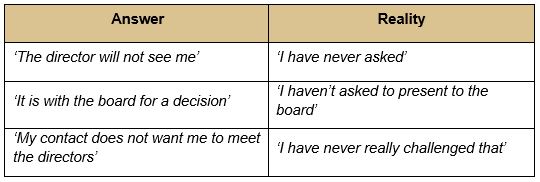How to Improve Your Sales Pipeline in 3 Steps
Does this conversation sound familiar?
Today
Sales Manager: When do you expect to close the deal with customer ABC?
Sales Person: Next month for sure.
One Month Later…
Sales Manager: I thought you were going to close the deal with customer ABC this month
Sales Person: Definitely next month.
Two Months Later
Sales Manager: What is happening with ABC deal?
Sales Person: Couple of problem, going to be next quarter now.
Next Quarter
Sales Manager: So when will the ABC deal expected to close?
Sales Person: Definitely before Christmas.
Sales Manager: This Christmas?
If you manage sales cycles, you may be familiar with conversations like this, conversations none of us enjoy!
However, there is a lot you can do to manage sales cycles and generate accurate pipeline forecasts!
Let’s take a step back. One of the common things I hear from customers is:
“We need to shorten the length of the sales cycle!”
My response is always:
“You cannot always shorten the sales cycle; you are subject to the customer’s decision-making process.”
However, you can manage the sales cycle professionally and be in a position to:
- Understand when a sales cycle is likely to close
- Identify actions you can take to move the sales cycle forward
- Decide if a potential sale should be included in your business forecast.
How to Improve Your Sales Pipeline in 3 Steps
High-value pipelines may assuage the conscience of underperforming sales people, but inaccurate or over-optimistic forecasts can cause sales leaders to make decisions that aren’t right for the business.
If you’re a sales leader, account manager or sales person, try these three actions to help manage your pipeline:
1. Meet the Stakeholders
A stakeholder is anyone who will control or influence a buying decision. If you are managing a sales opportunity and you know there are multiple stakeholders, go and meet them, don’t be put off by titles, reputation and position.
If you hear or use this statement
It’s all approved! We’re just waiting for sign off’
Then someone else is now selling your proposition to a stakeholder, without your input. Stop and think:
- Why isn’t it you making the sale?
- What is going to happen if a competitor is making the sale?
When sales managers and sales people are challenged on this the response, the reality is:

Just think:
- Why would you want someone else selling your proposition, surely you would do a better job!
- How could you put a forecast into the pipeline if you have not met all the stakeholders?
2: Establish the Decision Factors and Buying Motives
Every stakeholder will apply personal criteria to the decision-making process:
- Decision Factors: these are ‘must have’ criteria that your proposition must fulfil for a decision-maker to say yes.
- Buying Motives: emotional forces that influence decision-making. These are often irrational but it’s critical to know them, especially if the impact of a decision could have a positive or negative impact on a stakeholder’s role. The appeal of more responsibility, a bigger role or financial reward can all influence the likelihood of someone saying yes.
Customer needs, plus stakeholder decision factors and buying motives must be addressed by your proposal. Address them and your proposal becomes compelling, and your forecasts become accurate.
3: Manage the Dates
In every sales cycle, there are three key dates that should be agreed by the customer and you:
- Live Date: the date the customer will begin to use your products or services
- Decision Date: the date the customer will make a buying decision
- Proposal Date: the date you will provide the customer with a proposal
These dates are key to managing a sales cycle. Agree them with the customer and you establish a time table you can use to:
- Control the pipeline: each date acts as a catalyst to get things done e.g.
We need to get this data within 10 days, or we will miss the proposal date
- Assess customer commitment: if the customer is not demonstrating commitment to these dates, it maybe an indicator of how committed they are to doing business
- Make accurate forecasts: if the customer is committed to the dates and working to achieve them you can confidently forecast when sales revenue will come. Equally:
- How can you put a sales forecast into pipeline if you are not working on a timetable agreed with the customer?
- What good is a forecast based on assumptions?
Apply these three steps to your current sales cycles and you might discover there are things you need to do. Apply them long term and you will gain control of each sales cycle and discover you can forecast sales revenue with confidence.
Is there more?
There is much more you can do to manage the pipeline, but as a first step test these three actions on your current sales cycles.
Brett Lyons
Want to Get Started?
If you want to start a project to transform your business, call us to arrange
a consultation to discuss your needs and objectives.

